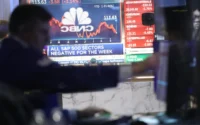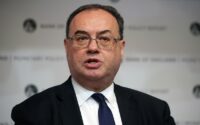The war against inflation is a long way away from being won
A food shopper searches for vegetables July 1, 2023 at the Hannaford supermarket in South Burlington, Vermont.
Robert Nickelsberg | Getty Images
Don’t break out the party hats just yet: Despite recent signs that inflation is cooling, the fight to bring down the meteoric price increases of the past three years is far from over.
Financial markets drew optimism from two reports last week showing that the rate of growth in both the prices that consumers shell out at the checkout and those that businesses pay for the goods they use had hit multiyear lows.
But those data points reflected relative rates of change, and didn’t capture the overall surge that led to the highest inflation level in more than 40 years. What’s more, there are still troubling undercurrents in the economy, such as rising fuel prices and a clogged housing market that could cause problems ahead.
“No victory laps. No mission accomplished. Our work is not done,” Jared Bernstein, chair of the White House’s Council of Economic Advisers, said during a CNBC “Squawk Box” interview Monday morning. “But we’re very happy to see some breathing room for American households.”
The consumer price index, a widely followed gauge that tracks dozens of goods and services across multiple sectors, increased just 0.2% in June, taking the annual rate to 3.1%. That latter figure is down precipitously from its 9.1% peak a year ago, which was the highest in nearly 41 years, and is at its lowest since March 2021.
Also last week, the Labor Department reported the producer price index had risen just 0.1% in June and the same amount on an annual basis. The 12-month PPI reading had peaked at an annual rate of 11.6% in March 2022, its highest ever in data going back to November 2010.
Sharp declines in both readings raised hopes that, with inflation getting ever closer to the Federal Reserve’s 2% target, the central bank could ease up on interest rate hikes and the tight monetary policy that has been implemented since the early part of 2022.
A temporary lull?
“Cooling inflation. Slowing but still positive job growth. These are the things that soft landings are made of,” Citigroup economist Andrew Hollenhorst said in a note. “Near-term price inflation may do little to contradict rising Fed official and market hope that a benign outcome is being achieved.”
However, Citi’s economic team is worried that the ideal conditions, which have included resilient consumer spending, stronger supply chains and receding prices in key areas such as energy and vehicles, may not last.
“Tight labor markets, elevated wages, and upside risks to shelter and other services inflation mean we do not share this optimism,” Hollenhorst added. “Absent a tightening of financial conditions, inflation may reaccelerate in early 2024.”
For their part, Fed officials have indicated they see their benchmark rate rising by at least half a percentage point by year-end. Chair Jerome Powell has repeatedly warned about reading too much into a few months of positive inflation data, noting that history shows such moves can be head fakes.
Warning signs abound
There is certainly reason for caution if not outright skepticism about where inflation is headed.
The easiest one to point to is that the CPI may be on a sharp decline when including all items, but the move is less impressive when excluding volatile food and energy prices. Energy has tumbled nearly 17% over the past year and can turn around quickly.
So-called core inflation rose 0.2% in June and was tracking at a 4.8% annual rate, much higher than the Fed would like.
Housing is another focal point.
Central to the Fed’s expectation that inflation will ease is the belief that rental costs will begin to subside after a housing price boom in the early days of the Covid pandemic. Shelter costs, though, rose another 0.4% in June and are now 7.8% higher than a year ago. That’s just off the peak earlier this year and still near the highest since the early 1980s.
When looking at prices through a longer lens, the CPI is still up about 18% from where it was three years ago, the recent easing notwithstanding.
There are other nettlesome points as well.
Health insurance costs have fallen nearly 25% over the past year, due in large part to a nebulous adjustment the Bureau of Labor Statistics applies to the category. The adjustment ends in a few months, meaning that category, though a small contributor to the CPI weighting, could become more of a factor.
Inflation has inflicted much pain
Fed officials have pledged not to be complacent about inflation, repeatedly expressing concern over the impact on lower-income families and workers.
Small businesses also have been hit hard both by rising prices and the higher interest rates the Fed has used in its efforts to restore price stability.
“Inflation has certainly changed the cost structure, in some instances maybe permanently for a lot of small businesses,” said David Cody, co-founder and co-CEO of Newity, which started during Covid as a conduit for Paycheck Protection Program loans and is now focused on providing loans solutions for small businesses.
“Not only do you have headwinds for growth as things slow down, which is what’s happening, but you also have high absolute rates and pricing pressure on inputs,” he added.
Coty said the current environment is highly challenging for small business financing and he doesn’t expect to see any benefits from lower inflation for a while.
“Things have to move quite a bit to change the landscape in a material way for those small businesses considering kind of all the headwinds that have been created in the last couple of years, including the pandemic,” he said.
To be sure, there’s also a good deal of evidence showing inflation heading in the right direction.
The easing in supply chain problems is probably the biggest positive factor. A New York Fed gauge of global supply chain pressures is near its lowest level since 2008.
Also, as consumers eat through excess savings built up from trillions in fiscal and monetary stimulus, demand likely will abate and put downward pressure on some key categories. Those trends could push the Fed to ease its foot off the brake.
“The underlying improvement in both core goods and services inflation won’t stop the Fed from hiking rates later this month but, assuming the trend continues, it should persuade the Fed to hold fire after that and, eventually, to begin cutting rates again in the first half of next year,” wrote Paul Ashworth, chief North America economist for Capital Economics.
The Commerce Department on Tuesday will provide a better look at the impact that inflation is having on spending.
Retail sales are expected to show growth of 0.5% in June, an important figure because it is not adjusted for inflation. If spending for the month does in fact exceed the level of price increases, that in itself could be inflationary.
“With the Fed’s temporary pause in rate hikes, the U.S. economy has proved to be resilient through continued consumer spending, but continuing that trend [at] the current rate could create an elevated new normal level of spending,” said Kavan Choksi, managing director at KC Consulting.
“The reality is that current inflation rates still hold a negative impact on consumers,” he added. “So, even though we are on the right trajectory, we still have a long way to go.”
[ad_2]
Source link


